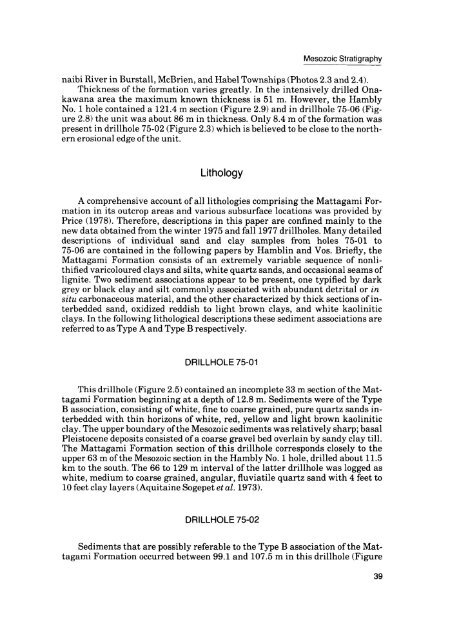Moose River Basin: geology and mineral potential - Geology Ontario
Moose River Basin: geology and mineral potential - Geology Ontario
Moose River Basin: geology and mineral potential - Geology Ontario
Create successful ePaper yourself
Turn your PDF publications into a flip-book with our unique Google optimized e-Paper software.
Mesozoic Stratigraphy<br />
naibi <strong>River</strong> in Burstall, McBrien, <strong>and</strong> Habel Townships (Photos 2.3 <strong>and</strong> 2.4).<br />
Thickness of the formation varies greatly. In the intensively drilled Ona<br />
kawana area the maximum known thickness is 51 m. However, the Hambly<br />
No. l hole contained a 121.4 m section (Figure 2.9) <strong>and</strong> in drillhole 75-06 (Fig<br />
ure 2.8) the unit was about 86 m in thickness. Only 8.4 m of the formation was<br />
present in drillhole 75-02 (Figure 2.3) which is believed to be close to the north<br />
ern erosional edge of the unit.<br />
Lithology<br />
A comprehensive account of all lithologies comprising the Mattagami For<br />
mation in its outcrop areas <strong>and</strong> various subsurface locations was provided by<br />
Price (1978). Therefore, descriptions in this paper are confined mainly to the<br />
new data obtained from the winter 1975 <strong>and</strong> fall 1977 drillholes. Many detailed<br />
descriptions of individual s<strong>and</strong> <strong>and</strong> clay samples from holes 75-01 to<br />
75-06 are contained in the following papers by Hamblin <strong>and</strong> Vos. Briefly, the<br />
Mattagami Formation consists of an extremely variable sequence of nonlithified<br />
varicoloured clays <strong>and</strong> silts, white quartz s<strong>and</strong>s, <strong>and</strong> occasional seams of<br />
lignite. Two sediment associations appear to be present, one typified by dark<br />
grey or black clay <strong>and</strong> silt commonly associated with abundant detrital or in<br />
situ carbonaceous material, <strong>and</strong> the other characterized by thick sections of in<br />
terbedded s<strong>and</strong>, oxidized reddish to light brown clays, <strong>and</strong> white kaolinitic<br />
clays. In the following lithological descriptions these sediment associations are<br />
referred to as Type A <strong>and</strong> Type B respectively.<br />
DRILLHOLE 75-01<br />
This drillhole (Figure 2.5) contained an incomplete 33 m section of the Mat<br />
tagami Formation beginning at a depth of 12.8 m. Sediments were of the Type<br />
B association, consisting of white, fine to coarse grained, pure quartz s<strong>and</strong>s in<br />
terbedded with thin horizons of white, red, yellow <strong>and</strong> light brown kaolinitic<br />
clay. The upper boundary of the Mesozoic sediments was relatively sharp; basal<br />
Pleistocene deposits consisted of a coarse gravel bed overlain by s<strong>and</strong>y clay till.<br />
The Mattagami Formation section of this drillhole corresponds closely to the<br />
upper 63 m of the Mesozoic section in the Hambly No. l hole, drilled about 11.5<br />
km to the south. The 66 to 129 m interval of the latter drillhole was logged as<br />
white, medium to coarse grained, angular, fluviatile quartz s<strong>and</strong> with 4 feet to<br />
10 feet clay layers (Aquitaine Sogepet et al. 1973).<br />
DRILLHOLE 75-02<br />
Sediments that are possibly referable to the Type B association of the Mat<br />
tagami Formation occurred between 99.1 <strong>and</strong> 107.5 m in this drillhole (Figure<br />
39

















